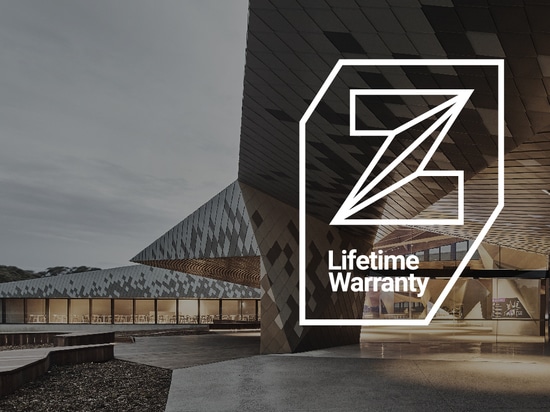
#Industry News
What are ventilated facades in zinc and why are they increasingly used?
Highly efficient construction solution for building envelopes, the zinc ventilated façade responds perfectly to the trends in sustainable architecture. By improving the energy efficiency and thermal insulation of buildings, it ensures sustainable and durable construction without compromising on design and aesthetics.
1. What is a ventilated facade?
The ventilated façade is a constructive solution for the waterproofing of the building’s vertical faces in which the exterior cladding is separated from the rest of the wall with an air cavity. It positions the insulation on the exterior face of the building, covering the edges of the floor slabs and the columns of the building. The exterior cladding is composed of panels with joints between them that are not necessarily rain-tight, and if not, it is the air cavity that keeps the building dry.
Focusing on ventilated facades in zinc, we see two types:
1.2. Self-supporting panel facades, with an air gap between the panels and the insulation
Self-supporting panel cladding is not necessarily rain-tight, and the joints between panels are either of the tongue and groove type or a shadow joint which is sometimes backed with a weathering strip.
Systems with rain-tight joints take air in at the foot of the façade and carry it up to the wall coping, where it is expelled.
On the other hand, air is allowed to flow around each panel in shadow-jointed systems.
1.2. Fully supported traditional facades with and an air space between the substrate and the insulation.
Traditional facades on the other hand are rain-tight, and are thus different from PER and DB/V systems. They employ seamed joints between panels, which are fixed to the substrate with stainless steel clips. The substrate is usually made of wooden sheathing or trapezoidal sheet metal. The ventilation of the facade is achieved by connecting the air cavity to an air inlet at the foot of the facade and to an outlet at the head, and its main mission is not to make the facade airtight (as it is in PER and DB/V systems), but to eliminate from within the façade any humid air coming from the interior and carry it upwards and out through the vent, avoiding interstitial condensation on the interior face of the zinc. When the facade is interrupted by windows, either the ventilation is diverted around them, or air outlets are incorporated under the window sills and air inlets in the lintels.
2. The advantages of the ventilated facade?
One of the main advantages of this construction solution, whatever the type, is the elimination of thermal bridges and the increase of insulation thickness without reducing the interior space. This substantially improves the thermal efficiency of the building.
In addition, it offers the following advantages:
- This solution eliminates damaging condensation caused by thermal bridges, thus greatly improving the thermal-hygrometric behaviour of the building.
- As the airtightness does not depend on seals, it is a more durable solution and is less dependent on good maintenance to continue to protect the building effectively.
- The zinc cladding with the air cavity behind it acts as a sunshade in summer, protecting the insulation from the heat of the sun and thus keeping the inside of the building cooler. And because the zinc sheets are thin, the mass of material heated during the day is less than, for example, in a stone or fair-faced brick facade, and therefore the heat returned to the air during the night is reduced, which mitigates the ‘heat island’ effect.
- Finally, and especially if the thermal insulation is rock wool, good acoustic insulation is achieved due to the acoustic energy absorption property of this type of insulation. The total acoustic absorption of the façade can be further increased by placing a structural underlay behind the zinc in traditional ventilated facades.
All these important functional advantages do not mean giving up ‘design’. Architects have at their disposal all the aesthetic possibilities offered by elZinc cladding, in all its surfaces, systems, lay-outs and dimensions, to create facades that are both visually striking and highly functional.
3. What parameters should be taken into account before designing a ventilated facade?
- The dimensions of the air space. It depends on the requirements of each country, but generally it varies from 20mm to 50mm.
- The sum total of the insulation thickness plus the cavity to properly size the wall brackets and rails.
- Reaction to Fire of the materials. As zinc is a non-combustible material, this mainly affects the substrate material in traditional zinc facades, which when required to be A1 or A2 class, is made from sheet metal.
- The positioning of the fire stops in the air cavity since the cavity provides a conduit through which fire can spread from floor to floor and across the building. The correct positioning of firestops to close the air cavity in case of fire must be taken into account.
4. Conclusion
The ventilated facade is an architectural solution that provides multiple benefits in terms of quality, savings, design and condensation control.
Combined with the great versatility of zinc-titanium, executed in zinc, they offer multiple possibilities in the design of a ventilated façade, resistance and durability.






